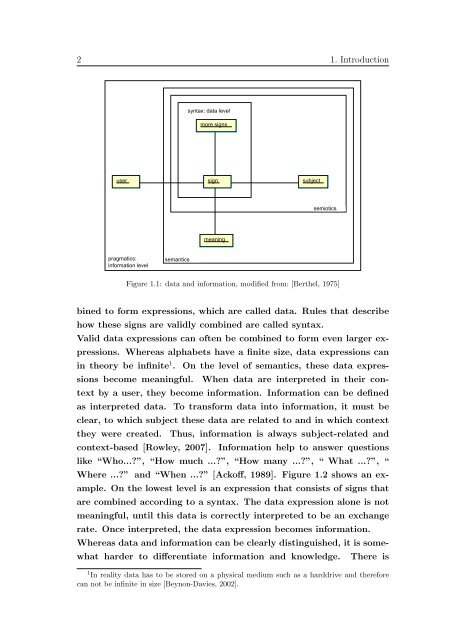Data integration in microbial genomics ... - Jacobs University
Data integration in microbial genomics ... - Jacobs University
Data integration in microbial genomics ... - Jacobs University
You also want an ePaper? Increase the reach of your titles
YUMPU automatically turns print PDFs into web optimized ePapers that Google loves.
2 1. Introduction<br />
syntax: data level<br />
more signs<br />
user<br />
sign<br />
subject<br />
semiotics<br />
mean<strong>in</strong>g<br />
pragmatics:<br />
<strong>in</strong>formation level<br />
semantics<br />
Figure 1.1: data and <strong>in</strong>formation, modified from: [Berthel, 1975]<br />
b<strong>in</strong>ed to form expressions, which are called data. Rules that describe<br />
how these signs are validly comb<strong>in</strong>ed are called syntax.<br />
Valid data expressions can often be comb<strong>in</strong>ed to form even larger expressions.<br />
Whereas alphabets have a f<strong>in</strong>ite size, data expressions can<br />
<strong>in</strong> theory be <strong>in</strong>f<strong>in</strong>ite 1 .<br />
On the level of semantics, these data expressions<br />
become mean<strong>in</strong>gful.<br />
When data are <strong>in</strong>terpreted <strong>in</strong> their context<br />
by a user, they become <strong>in</strong>formation. Information can be def<strong>in</strong>ed<br />
as <strong>in</strong>terpreted data. To transform data <strong>in</strong>to <strong>in</strong>formation, it must be<br />
clear, to which subject these data are related to and <strong>in</strong> which context<br />
they were created.<br />
context-based [Rowley, 2007].<br />
Thus, <strong>in</strong>formation is always subject-related and<br />
Information help to answer questions<br />
like “Who...?”, “How much ...?”, “How many ...?”, “ What ...?”, “<br />
Where ...?” and “When ...?” [Ackoff, 1989]. Figure 1.2 shows an example.<br />
On the lowest level is an expression that consists of signs that<br />
are comb<strong>in</strong>ed accord<strong>in</strong>g to a syntax. The data expression alone is not<br />
mean<strong>in</strong>gful, until this data is correctly <strong>in</strong>terpreted to be an exchange<br />
rate. Once <strong>in</strong>terpreted, the data expression becomes <strong>in</strong>formation.<br />
Whereas data and <strong>in</strong>formation can be clearly dist<strong>in</strong>guished, it is somewhat<br />
harder to differentiate <strong>in</strong>formation and knowledge.<br />
There is<br />
1 In reality data has to be stored on a physical medium such as a harddrive and therefore<br />
can not be <strong>in</strong>f<strong>in</strong>ite <strong>in</strong> size [Beynon-Davies, 2002].

















